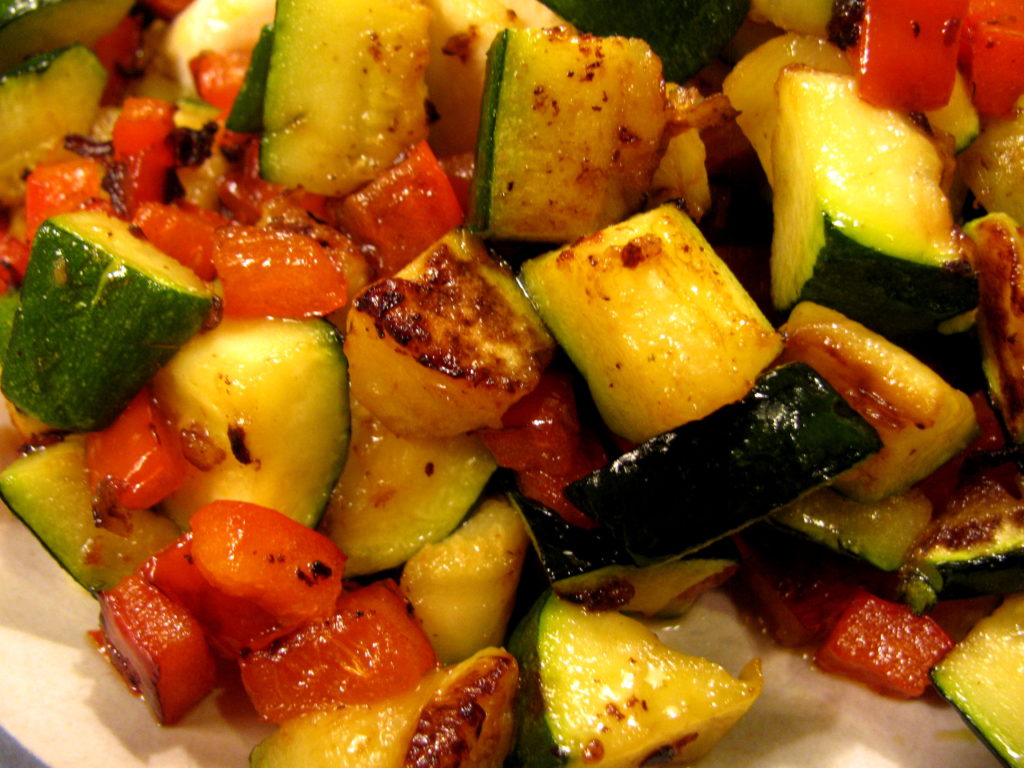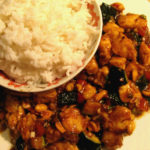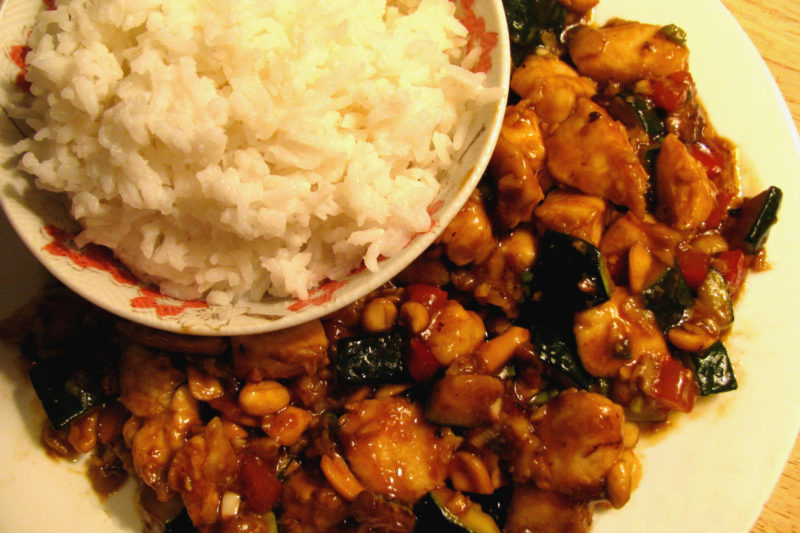For a person who loves to cook, I certainly eat a lot of Chinese take-out. My go-to is almost always Kung Pao Chicken. I refuse to order from a restaurant that serves an inferior version of the stuff. My ideal Kung Pao Chicken has a generous amount of heat, a thick, slightly sweet and tangy sauce, more chicken than peanuts, and not too much vegetation. Sometimes you need lighter fare, like my Vegan Cashew Cream Spinach Dip, and sometimes you just need to focus on something a little heartier, like chicken and rice in a perfectly-flavored sauce.
When you look at the list of ingredients required to cook Chinese food at home, it can seem a little intimidating. You will almost definitely need to purchase some new sauce or oil in order to get your flavors the way you want them. I’ve found, however, that those new ingredients become an investment, as a lot of Chinese food isn’t nearly as difficult to prepare as you expect. Having the ingredients on hand will make future cooking experiments that much easier, and a lot of them are shelf-stable products that will keep for a long time.
This is a recipe that I’ve developed myself as a conglomeration of many other versions. I started with an All Recipes version, and got some inspiration from Dinner, then Dessert – hers is a Panda Express Copycat version. My love for Kung Pao Chicken actually started in college with Panda Express, and developed as I started ordering it everywhere! I kept my vegetables similar to theirs, with zucchini and red bell pepper, but my sauce has a little more complexity, and a bit more heat.

One of the most important steps in the recipe is velveting the chicken, which can be done a couple of ways. You start by soaking your sliced chicken pieces in a mixture of water, cornstarch, salt, and in this case, egg, for around an hour. Then the meat cooks at very high heat in oil for a minute or two. This process helps keep the meat tender and prevents it from drying out. It’s a pretty simple process, but it makes a world of difference in your end product. Read more about how to perfect this technique here.
Now, I’ve been saying that this is Chinese food. But I think we all know that this is probably not authentic Chinese food. This is very American Chinese food. I have never been to China, and although I would love to go someday, I am definitely not an authority on real Chinese food. The only thing truly Chinese about this post is the chopsticks – they were a souvenir brought back by my uncle.

Authentic or not, I think this is a great recipe for people just starting out in this type of cuisine. It’s truly not as complex as it might seem, and the recipe is fairly forgiving. You can go with different vegetables or add more, and you can reduce or increase the heat based on your preferences. Simply put, the steps are: velvet your chicken, saute your vegetables until soft but not mushy, heat your sauce, and combine everything for a seriously delicious dinner.
Bonus: This Kung Pao Chicken recipe is here just in time for you to make it in celebration! The Chinese New Year begins on January 28, and we’re entering The Year of the Rooster.

Kung Pao Chicken - DIY Takeout
Ingredients
- 1 lb chicken breast
- 1 medium red bell pepper
- 1 medium zucchini
- 2 Tbsp vegetable oil
- 1/4 cup cornstarch
- 1/4 cup water
- 1/2 egg whisked before adding
- 1/2 tsp salt
Sauce
- 2 1/2 Tbsp sesame chili oil I used Dynasty Sesame Chili Oil
- 2 Tbsp rice vinegar
- 4 Tbsp soy sauce
- 2 Tbsp white wine
- 2 1/2 Tbsp brown sugar
- 1/4 cup chopped scallions
- 1 Tbsp chopped garlic
- 1/2 cup chopped peanuts 2 oz
- 1 tsp Worcestershire sauce
- 1 dash ground ginger
- 2 Tbsp cornstarch dissolved in 3 Tbsp water
- 1/4 cup chicken broth
Instructions
-
Step 1: Slice chicken breast into thin pieces, about bite-sized. In a large bowl, mix 1/4 cup cornstarch, 1/4 water, salt and egg (crack the egg into separate bowl, whisk until white and yolk are combined, and add half to your cornstarch mixture). Add chicken to mixture and stir until well coated, cover with plastic wrap, and refrigerate for 1 hour. If you plan to serve rice with this dish, start it now.
Step 2: Stir 2 Tbsp of cornstarch into 3 Tbsp of water. Stir in sesame chili oil, rice vinegar, soy sauce, white wine, brown sugar, Worcestershire sauce, and ground ginger. Chop scallions and garlic, and roughly chop peanuts, and add to the sauce mixture.
Step 3: Dice the zucchini and red bell pepper.
Step 4: Velvet your chicken: Heat up a large skillet or wok - let it get very hot. Add 2 Tbsps of vegetable oil to the skillet, and then add your chicken. It will cook very quickly. Push it around with a spatula. Keep the chicken on the heat until cooked all the way through, then remove from heat. At this point, the chicken will not be very pretty, because it will have its cornstarch/egg mixture coating.
Step 5: Add a little more vegetable oil to the same skillet, and toss in the zucchini and bell peppers. Sprinkle with just a pinch of salt, and cook over medium heat until they become tender, and just slightly browned. Remove from heat - vegetables can just be piled on top of your chicken.
Step 6: Lower the heat, and pour sauce into the same skillet. Let sauce cook until it thickens. Pour chicken broth into the sauce, and stir. The sauce should be dark, and should start to thicken again right after the chicken broth has been stirred in. You can add more chicken broth to thin the sauce, if it has gotten too thick. Don't add water, as that will dilute your flavors. Let the sauce cook until it has reached a thick, but still slightly runny, consistency.
Step 7: Remove pan from heat, and stir in chicken and vegetables. Enjoy your dish!
Note: This recipe makes a fairly spicy Kung Pao Chicken. In order to decrease the heat level, reduce sesame chili oil, or replace part of it with plain sesame oil.

